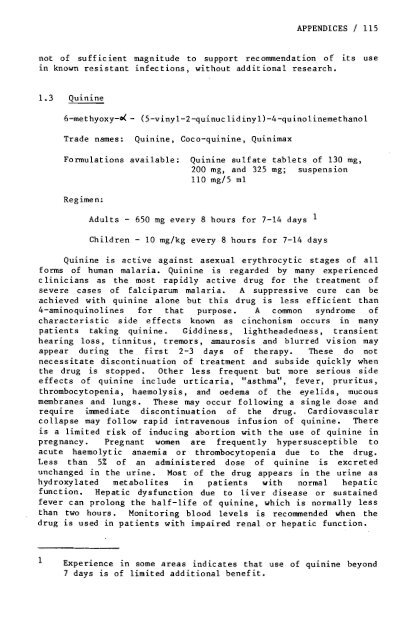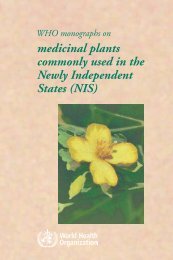Drug-Resistant Malaria - libdoc.who.int - World Health Organization
Drug-Resistant Malaria - libdoc.who.int - World Health Organization
Drug-Resistant Malaria - libdoc.who.int - World Health Organization
Create successful ePaper yourself
Turn your PDF publications into a flip-book with our unique Google optimized e-Paper software.
APPENDICES / 115<br />
not of sufficient magnitude to support recormnendation of its use<br />
in known resistant infections, without additional research.<br />
1.3 Quinine<br />
6-methyoxy-~ -<br />
Trade names:<br />
(5-vinyl-2-quinuclidinyl)-4-quinolinemethanol<br />
Quinine, Coco-quinine, Quinimax<br />
Formulations available: Quinine sulfate tablets of 130 mg,<br />
200 mg, and 325 mg; suspension<br />
110 mg/5 ml<br />
Regimen:<br />
Adults - 650 mg every 8 hours for 7-14 days 1<br />
Children -<br />
10 mg/kg every 8 hours for 7-14 days<br />
Quinine is active against asexual erythrocytic stages of all<br />
forms of human malaria. Quinine is regarded by many experienced<br />
clinicians as the most rapidly active drug for the treatment of<br />
severe cases of falciparum malaria. A suppressive cure can be<br />
achieved with quinine alone but this drug is less efficient than<br />
4-aminoquinolines for that purpose. A common syndrome of<br />
characteristic side effects known as cinchonism occurs in many<br />
patients taking quinine. Giddiness, lightheadedness, transient<br />
hearing loss, tinnitus, tremors, amaurosis and blurred vision may<br />
appear during the first 2-3 days of therapy. These do not<br />
necessitate discontinuation of treatment and subs ide quickly when<br />
the drug is stopped. Other less frequent but more serious side<br />
effects of quinine include urticaria, "asthma", fever, pruritus,<br />
thrombocytopenia, haemolysis, and oedema of the eyelids, mucous<br />
membranes and lungs. These may occur following a sing le dose and<br />
require irmnediate discontinuation of the drug. Cardiovascular<br />
collapse may follow rapid <strong>int</strong>ravenous infusion of quinine. There<br />
is a limited risk of inducing abortion with the use of quinine in<br />
pregnancy. Pregnant women are frequently hypersusceptible to<br />
acute haemolytic anaemia or thrombocytopenia due to the drug.<br />
Less than 5% of an administered dose of quinine is excreted<br />
unchanged in the urine. Most of the drug appears in the urine as<br />
hydroxylated metabolites in patients with normal hepatic<br />
function. Hepatic dysfunction due to liver disease or sustained<br />
fever can prolong the half-life of quinine, which is normally less<br />
than two hours. Monitoring blood levels is recormnended when the<br />
drug is used 1n patients with impaired renal or hepatic function.<br />
1 Experience in some areas indicates that use of quinine beyond<br />
7 days is of limited additional benefit.
















